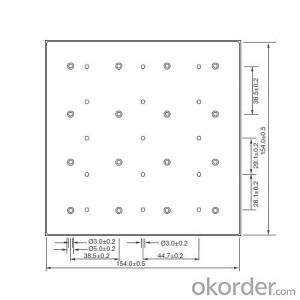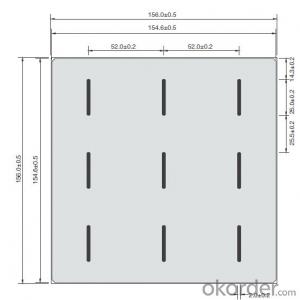Polycrystal Solar Cell Pn Junction Jac P6WR-0 (MWT)
- Loading Port:
- China main port
- Payment Terms:
- TT OR LC
- Min Order Qty:
- 1000 watt
- Supply Capability:
- 1000000 watt/month
OKorder Service Pledge
OKorder Financial Service
You Might Also Like
JACP6WR-0 POLYCRYSTALLINE SILICON SOLAR CELL
JA solar's high effciency MWT poly cell, manufacturing modules with more than 265W(6x10)power putput becomes easier than ever.
Futures:
Format:156mmx156mm±0.5mm
thickness:210um±30um
Front:Blue anti-reflecting coating (silicon nitride)
back:31 contact pads in diameter 3mm
Data sheet


FAQ
We have organized several common questions for our clients,may help you sincerely:
①How about your company?
CNBM Solar photovoltaic (PV) Panel has various wattage from 1.5W to 315W to meet the demand of every customer. It is the optimal choice for both on-grid and off-grid power systems. CNBM Solar panel offers high performance of power warranty and good after sale service, we have professional people to reply your problem anytime.
CNBM International Corporation's products including Monocrystalline Solar Panel, Polycrystalline Solar Panel have received and enjoyed famous reputation in many countries and regions in the world .As a solar panel supplier in China, we strive to provide our customers with excellent service, superior products and unmatched value.
②How to guarantee the quality of the products?
CNBM Solar performance guarantees for 25 years
• 12 years guarantee for workmanship
• Timeliness of delivery
• Quality Products certified (TÜV, UL, CE, ISO)
③How long can we receive the product after purchase?
In the purchase of product within three working days, We will arrange the factory delivery as soon as possible. The pecific time of receiving is related to the state and position of customers.Commonly 7 to 10 working days can be served.
- Q: How does the efficiency of solar cells vary with different materials?
- The efficiency of solar cells can vary greatly with different materials. Some materials, such as silicon, have high efficiency rates as they are able to effectively convert sunlight into electricity. Other materials, like organic polymers, have lower efficiency rates due to their limited ability to absorb and convert sunlight. Additionally, the efficiency can also depend on factors such as the purity and thickness of the material used. Overall, the choice of material greatly impacts the efficiency and performance of solar cells.
- Q: Are solar cells durable?
- Yes, solar cells are generally durable. They are designed to withstand various weather conditions, including rain, snow, and extreme temperatures. Additionally, most solar cells come with warranties that guarantee their performance for several decades.
- Q: Can solar cells be used to power electric vehicle charging stations?
- Yes, solar cells can be used to power electric vehicle charging stations. Solar panels convert sunlight into electricity, which can then be used to charge electric vehicles. This is known as solar-powered EV charging infrastructure, and it offers a sustainable and renewable energy solution for electric vehicle owners.
- Q: Can solar cells be used in shopping centers?
- Yes, solar cells can be used in shopping centers. They can be installed on the rooftops or in parking lots to generate clean and renewable energy to power the shopping center's operations. Solar cells provide cost savings on electricity bills and reduce carbon emissions, making them an environmentally friendly choice for shopping centers.
- Q: How do solar cells perform in tropical climates?
- Solar cells perform well in tropical climates due to the abundance of sunlight and high temperatures. The intense sunlight provides optimal conditions for solar energy generation, allowing the cells to produce electricity efficiently. However, the high temperatures can cause some decrease in performance, as solar cells are sensitive to heat. Proper maintenance and cooling techniques can mitigate this issue and ensure consistent performance. Overall, solar cells are highly effective in tropical climates and can play a significant role in meeting the energy demands of these regions.
- Q: Can solar cells be used in telecommunications infrastructure?
- Yes, solar cells can be used in telecommunications infrastructure. They can be used to power various equipment such as base stations, repeaters, and remote monitoring systems. Solar power provides a reliable and sustainable energy source that can be utilized in remote or off-grid locations, reducing dependence on traditional power sources and lowering operational costs. Additionally, solar cells have a longer lifespan and require minimal maintenance, making them an ideal option for powering telecommunications infrastructure.
- Q: What is the environmental impact of manufacturing solar cells?
- The manufacturing of solar cells has both positive and negative environmental impacts. On the positive side, solar cells generate clean and renewable energy, reducing the reliance on fossil fuels and thereby decreasing greenhouse gas emissions and air pollution. Additionally, solar cells have a long lifespan and require minimal maintenance, reducing the overall environmental impact compared to other energy sources. However, the production process of solar cells does have some negative environmental consequences. The extraction of raw materials, such as silicon and rare earth metals, can lead to habitat destruction, water pollution, and soil degradation. The manufacturing process also requires energy and water, which can contribute to carbon emissions and water scarcity if not managed efficiently. Overall, while the production of solar cells does have some environmental impacts, it is important to consider them in relation to the significant environmental benefits that solar energy provides in terms of reducing carbon emissions and mitigating climate change.
- Q: Can solar cells be used for powering remote mining operations?
- Yes, solar cells can be used for powering remote mining operations. Solar energy is a reliable and sustainable power source that can be harnessed in remote locations where traditional power infrastructure is unavailable or costly to implement. Solar panels can generate electricity during daylight hours, which can be stored in batteries for use during nighttime or cloudy periods. This makes solar cells a practical and eco-friendly solution for powering remote mining operations, reducing reliance on fossil fuels and minimizing the environmental impact.
- Q: How does the size of a solar cell affect its performance?
- The size of a solar cell directly affects its performance. Larger solar cells have a higher surface area, allowing them to capture more sunlight and generate more electricity. This results in a higher power output and overall performance compared to smaller solar cells.
- Q: How does the solar cell work properly?
- It has to follow certain scientific steps to make it work properly.
Send your message to us
Polycrystal Solar Cell Pn Junction Jac P6WR-0 (MWT)
- Loading Port:
- China main port
- Payment Terms:
- TT OR LC
- Min Order Qty:
- 1000 watt
- Supply Capability:
- 1000000 watt/month
OKorder Service Pledge
OKorder Financial Service
Similar products
Hot products
Hot Searches
Related keywords























